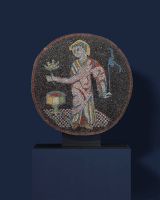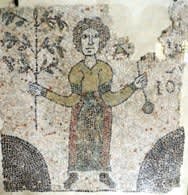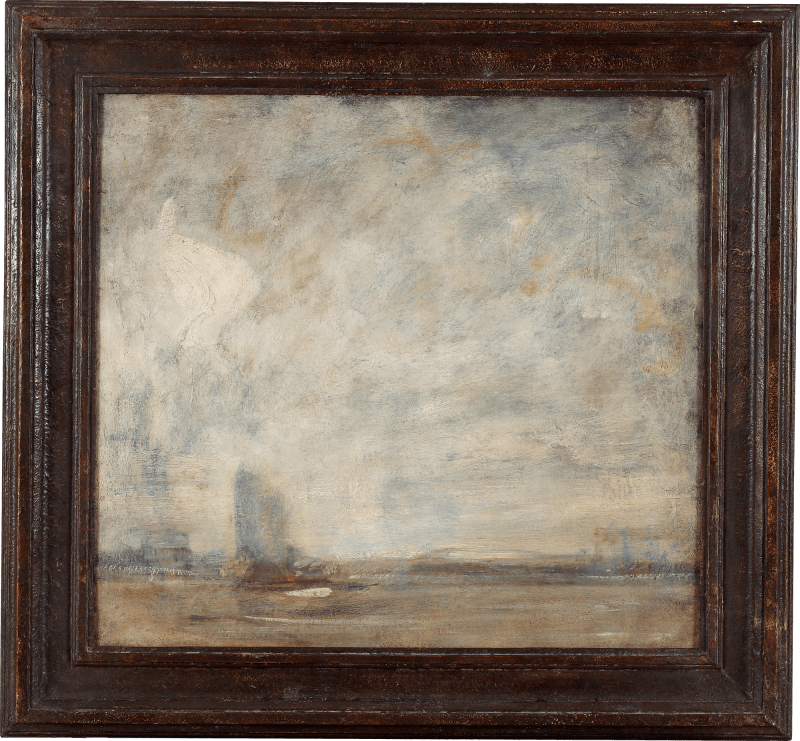This exceptional work was created in 1913 by the avant-garde mosaicist and artist, Boris Anrep, and was acquired soon after by the artist Augustus John, who set it into the wall of his house in Chelsea, where it remained until 1970. It is the only example of Anrep’s work to appear on the secondary market since his death and has not been exhibited in public since it was shown in Anrep’s first solo exhibition in 1913.
The figure in this work has recently been identified as the international ballet dancer Vaslav Nijinsky, star of Sergei Diaghilev’s Ballets Russes, which first graced London’s theatres in 1911.[1] Anrep met Nijinsky through the arts patron Lady Ottoline Morrell and they bonded over their mutual fascination for Russian myths and religion. Anrep frequently cast his artistic and literary friends in creative schemes during his early career, and his depiction of Nijinsky captures the extravagance of his balletic positions, and the blue tone of...
This exceptional work was created in 1913 by the avant-garde mosaicist and artist, Boris Anrep, and was acquired soon after by the artist Augustus John, who set it into the wall of his house in Chelsea, where it remained until 1970. It is the only example of Anrep’s work to appear on the secondary market since his death and has not been exhibited in public since it was shown in Anrep’s first solo exhibition in 1913.
The figure in this work has recently been identified as the international ballet dancer Vaslav Nijinsky, star of Sergei Diaghilev’s Ballets Russes, which first graced London’s theatres in 1911.[1] Anrep met Nijinsky through the arts patron Lady Ottoline Morrell and they bonded over their mutual fascination for Russian myths and religion. Anrep frequently cast his artistic and literary friends in creative schemes during his early career, and his depiction of Nijinsky captures the extravagance of his balletic positions, and the blue tone of the figure’s skin tone is likely a reference to Nijinsky’s recent appearance as the Blue God in the 1912 performance of Le Dieu bleu. Depicted in a temple-like-setting, Anrep also references the plot of La Péri, a Persian fable turned ballet for which Nijinsky was originally cast, but was later cancelled, in which the main character seeks to obtain a lotus flower which provides eternal life. Spirit of Reasoning, the title of this mosaic when exhibited, can also be linked to this fable.
Anrep was highly influenced by modernist culture, yet his fusion of modernism with traditional Byzantine art was what piqued the interest of his peers. In 1912, the year before this work was produced, he was asked by Roger Fry to curate the Russian section of his seminal Second Post-Impressionist Exhibition at the Grafton Galleries. This brought him into closer contact with the Bloomsbury group and the artists later working in the Omega Workshops.
The influence of Byzantine art is particularly apparent in the present mosaic. Anrep was inspired by the linear outline and abstracted schemata of the mosaics he had seen on a recent visit to Italy [fig. 1]. Dr Jane Williams has recently shed new light on Anrep’s technique in her unpublished thesis; ‘Anrep was inspired by many of the elements found in Byzantine mosaics: the abstracted schematic form, the flattened two-dimensional forms that produced a static effect, the inverted or reverse perspective that denies the reality of space, the sense of decoration, the imaginative colouring, and finally the inherent spirituality. It was the interpretation of these components that he shared with the Bloomsbury’s group as part of a new sympathy towards Byzantine art.’[2] The bold outline of the figure adheres to Anrep’s fusion of Byzantine candour with modernism. It is a melange of contemporary influences, from the echo of Matisse’s bright colour palette to Nijinsky’s balletic abilities. Seamlessly peppering his cryptic work with both contemporary and historic references, Anrep appears to have also taken inspiration from an Imperial Roman mosaic at the Louvre for the flooring below the figure [fig. 2].
Anrep’s rise to prominence was due in no small part to his friendship with Augustus John, one of the most prominent British artists of the early twentieth century. John admired Anrep not only for his artistic talent but also for his bohemian lifestyle, and along with his partner Dorelia, persuaded James Knewstub, the owner of the Chenil Gallery in Chelsea, to host Anrep’s first solo exhibition in October 1913, in which the present work was exhibited. It was Anrep’s first and only solo show held during his lifetime and launched his career as a mosaicist.
The exhibition introduced his revivalist approach to mosaic art to a wide audience and restored the ancient art of mosaic to modern relevance. The show featured mosaics, paintings, drawings, a book of poetry, and designed blouses embroidered by Anrep's first wife, Yunia. The eclectic nature of the exhibition aligned with the ethos of the Bloomsbury Group and Roger Fry’s Omega Workshops, which had opened earlier that year and dismissed the boundaries between fine and decorative arts. Anrep’s mosaics, in particular, were highly praised: ‘Boris von Anrep’s works are much more attractive, and in some instances exceedingly beautiful.’ [3] In his forward to the exhibition catalogue, Fry wrote ‘He sees his figures as single easily apprehended rhythm’.[4]
Augustus John appreciated the enormity of Anrep’s vision and purchased the present mosaic from the Chenil exhibition, which he installed at his newly built house at 28 Mallord Street London. Built between 1913 to 1914 from designs by the Dutch architect Robert van’t Hoff, John described 28 Mallord Street as ‘my new studio with living rooms’. In 1919, he commissioned Anrep to produce a colossal overmantel mosaic depicting John and his family [fig. 3]; the monumentality of the work stands as a testimony of John’s conviction in Anrep’s vision. In 1934, John sold his Mallord Street home to the singer Gracie Fields, after which point both mosaics were subsequently covered up, and only rediscovered when a later owner of the property redecorated the house in 1970. The large overmantel was removed and is now at the Victoria & Albert Museum, London, where it remains today.[5]
Anrep's mosaic art is marked by its ambiguous elements. In his own words, he aimed to capture ‘the embodiment of purely spiritual qualities’ in his art.[6] Spirit of Reasoning reveals Anrep's early fascination with religion and spirituality, not only through its title but also through the stylised subject matter. Many of Anrep’s later mosaics found their home in churches, chapels, and cathedrals, evincing his uncanny ability to infuse spiritual meaning into his creations. His first commission after the Chenil exhibition was the ceiling of a crypt in Westminster Cathedral. He went on to mosaics for a number of significant locations and institutions, including the National Gallery, London.
We are grateful to Dr. Jane Williams for her assistance and contributions to this cataloguing.
[1] We are grateful to Dr. J. Williams for her identification.
[2] Dr. J. Williams, ‘The Mosaic Portraits of Boris Anrep: 1913-1952’, Thesis: University of Reading, p. 24.
[3] The Queen, The Lady’s Newspaper. 25 October 1913.
[4] R. Fry, Works by Boris von Anrep. London: The Chenil Gallery, 1913, p. 3.
[5] Accession Number A.7PART/1-1971.
[6] B. Anrep, Works by Boris von Anrep. London: The Chenil Gallery, 1913.





















